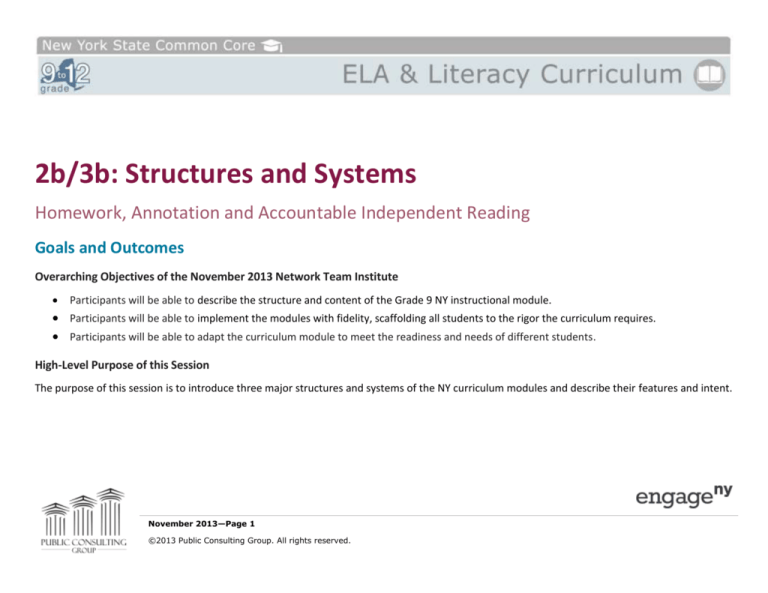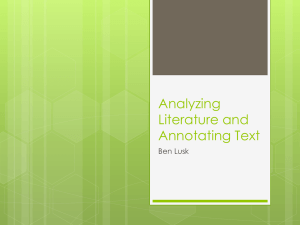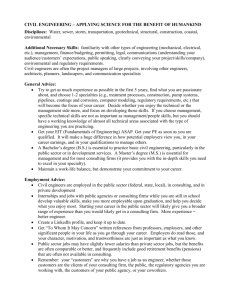
2b/3b: Structures and Systems
Homework, Annotation and Accountable Independent Reading
Goals and Outcomes
Overarching Objectives of the November 2013 Network Team Institute
Participants will be able to describe the structure and content of the Grade 9 NY instructional module.
Participants will be able to implement the modules with fidelity, scaffolding all students to the rigor the curriculum requires.
Participants will be able to adapt the curriculum module to meet the readiness and needs of different students.
High-Level Purpose of this Session
The purpose of this session is to introduce three major structures and systems of the NY curriculum modules and describe their features and intent.
November 2013—Page 1
©2013 Public Consulting Group. All rights reserved.
New York State Common Core
Session Outcomes
What do we want participants to be able to do as a result of this session?
Understand the features and intent of homework, annotation and accountable
independent reading systems
Identify ways in which these structures and systems support instruction and the
instructional shifts and standards
How will we know that they are able to do this?
Aligned survey question
Related Learning Experiences
Session 1a: Introduction to the Curriculum Materials: Digging into the Modules
Session 2a/3a: Scaffolding to Rigor in High School English Language Arts: Supporting Student Access to Complex Texts
Session 4b: Identifying CCSS-Aligned Instruction: Recognizing Effective Instructional Practices
Key Points
Structures and systems are designed to support instruction and enrich the curriculum.
Homework, Independent Reading and Annotation are designed to help students learn the curriculum and meet the standards.
These systems can be adapted to best meet students’ needs.
November 2013—Page 2
©2013 Public Consulting Group. All rights reserved.
New York State Common Core
Session Overview
Section
Time
Overview
Introduction
5 min
Introduction to Session
Prepared Resources
Session PowerPoint
Facilitator Preparation
Position microphone runners at
various spots around the room
for report out.
Session PowerPoint
Lesson excerpts:
Homework
25 min
Accountable
Independent Reading
(AIR)
20 min
Participants explore key design
features and purposes of
homework and consider
approaches to implementation.
Participants explore key design
features and purposes of
accountable independent reading
and consider approaches to
implementation.
9.1, Unit 2, Lesson 5
9.1, Unit 2, Lesson 6 (p. 3)
9.1, Unit 3, Lesson 2
9.1, Unit 3, Lesson 3 (pp. 45)
9.1, Unit 3, Lesson 5
9.1, Unit 3, Lesson 6 (p.4)
Session PowerPoint
Prefatory material Part 2
(pp. 4-6)
Lesson excerpts:
November 2013—Page 3
©2013 Public Consulting Group. All rights reserved.
Position microphone runners at
various spots around the room
for report out.
9.1, Unit 1 Lesson 5, pp. 910
9.1 Unit 1, Lesson 6 p. 4
Position microphone runners at
various spots around the room
for report out.
New York State Common Core
Section
Annotation
Session Reflection
Time
30 min
Overview
Participants explore key design
features and purposes of
annotation and consider
approaches to implementation.
Participants reflect on learning
and consider implications for
practice
10 min
90 mins
Total for this session
November 2013—Page 4
©2013 Public Consulting Group. All rights reserved.
Prepared Resources
Session PowerPoint
Lesson excerpts:
Unit 1 Lesson 3 (pp. 5-7)
Unit 1 Lesson 5 (pp. 3-8)
Unit 2 Lesson 7 (p. 4)
Session PowerPoint
Facilitator Preparation
Position microphone runners at
various spots around the room
for report out.
Position microphone runners at
various spots around the room
for report out.
New York State Common Core
Session Roadmap
Section: Introduction
In this section, you will discuss the distinction between curriculum
content and the systems/structures that support curriculum and
instruction.
Slide
Time
1
0 min
Picture
Materials used include: Session PowerPoint
Script/Activity directions
Welcome participants to session
November 2013—Page 5
©2013 Public Consulting Group. All rights reserved.
New York State Common Core
Slide
Time
2
1 min
Picture
Script/Activity directions
Review the purpose of this session: Participants will be able to:
November 2013—Page 6
©2013 Public Consulting Group. All rights reserved.
Understand the features and intent of homework, annotation and
accountable independent reading systems
Identify ways in which these structures and systems support
instruction and the instructional shifts and standards
New York State Common Core
Slide
Time
3
3 min
Picture
Script/Activity directions
Explain the distinctions between curriculum (content), instruction
(delivery), and structures and systems.
Key points: Structures and systems are designed to support instruction
and enrich the curriculum.
November 2013—Page 7
©2013 Public Consulting Group. All rights reserved.
New York State Common Core
Slide
Time
4
1 min
Total
time:
Picture
Script/Activity directions
Review the three structures and systems in the NY curriculum modules:
5 min
November 2013—Page 8
©2013 Public Consulting Group. All rights reserved.
•
Homework
•
Annotation
•
Accountable Independent Reading
New York State Common Core
Section: Homework
In this section, you will learn the purpose and design of homework and
homework accountability in the NY Curriculum Modules.
Slide Time Picture
5
3 min
Materials used include: Session PowerPoint and Lesson excerpts:
•
•
•
Set 1: 9.1, Unit 2, Lesson 5; 9.1, Unit 2, Lesson 6 (p. 3)
Set 2: 9.1, Unit 3, Lesson 2; 9.1, Unit 3, Lesson 3 (focus on pp. 4-5)
Set 3: 9.1, Unit 3, Lesson 5; 9.1, Unit 3, Lesson 6 (p.4)
Script/Activity directions
Review the design and purposes of homework:
Consistent rigorous homework assignments are informed by research and
scaffolded to build students’ skills and increase their ability to learn the
curriculum.
Homework is also designed to prepare students for college and careers by:
Addressing the volume of reading they will encounter in college
Building students’ analytical and processing skills through rigorous,
reflective writing assignments
Promoting consistent in-depth exploration of texts by extending the
day’s learning or preparing students for the following day’s lesson
Furthermore, accountable independent reading assignments build students’
familiarity with the standards and help practice the skills they prescribe.
November 2013—Page 9
©2013 Public Consulting Group. All rights reserved.
New York State Common Core
Slide Time Picture
6
3 min
Script/Activity directions
Review the key design features of homework:
•
Assigned everyday
•
Students are expected to do 45 min/night
•
Types of homework:
Reflective Writing Assignments
Accountable Independent Reading (AIR)
Assignments that extend the day’s learning or prepare students
for the following day’s lesson
November 2013—Page 10
©2013 Public Consulting Group. All rights reserved.
New York State Common Core
Slide Time Picture
7
12
min
Script/Activity directions
Direct pairs (or trios) to complete a jigsaw activity by reading one set of
homework and homework accountability excerpts per pair, focusing on its
connections to lesson instruction (6 minutes):
• Set 1: 9.1, Unit 2, Lesson 5; 9.1, Unit 2, Lesson 6 (p. 3)
• Set 2: 9.1, Unit 3, Lesson 2; 9.1, Unit 3, Lesson 3 (focus on pp. 4-5)
• Set 3: 9.1, Unit 3, Lesson 5; 9.1, Unit 3, Lesson 6 (p.4)
As a whole table, discuss the following questions (6 minutes):
• What connections do you notice between the homework assignment
and the lesson instruction and assessment?
• What do you notice about the ways in which students are held
accountable for doing homework?
• What impact does this have on the lesson you just read?
• What do you notice about the effect of homework structures on
teacher time?
Key points:
• Homework is tightly connected to lesson instruction.
• Homework is designed to extend the day’s learning but never to
complete unfinished activities.
• Homework accountability generally consists of a brief discussion or cold
call at the beginning of class, helping to make it low-impact on
teachers.
November 2013—Page 11
©2013 Public Consulting Group. All rights reserved.
New York State Common Core
Slide Time Picture
8
7 min
Script/Activity directions
Have participants discuss in table groups:
•
What’s different about the NY Curriculum Modules’ approach to
Homework?
•
Which pieces of this system currently exist in your school or district?
Which pieces push your thinking?
•
What challenges do you anticipate? What ideas do you have to meet
those challenges?
Key Points:
Total
time:
25
mins
November 2013—Page 12
©2013 Public Consulting Group. All rights reserved.
Homework is a reflective, rigorous activity designed to deepen student
learning and is strongly tied to the text.
Having students complete homework on a nightly basis may require a
real culture shift in many schools. In order for implementation to be
successful, teachers, school leaders and entire school communities may
need to be on board with a rigorous homework and accountability
system.
New York State Common Core
Section: Accountable Independent Reading (AIR)
In this section, you will learn the purpose and design of Accountable
Independent Reading in the NY Curriculum modules.
Slide Time Picture
9
8 min
Materials used include: Session PowerPoint and lesson excerpts:
•
9.1 Unit 1, Lesson 5 pp. 9-10
•
9.1 Unit 1, Lesson 6 p. 4
Script/Activity directions
Direct participants to independently review the Prefatory material focusing on
Part 2 “Our Approach to Homework” (pp. 4-6). Explain that these pages outline
the NY curriculum modules approach to Accountable Independent Reading.
3 minutes
In pairs, discuss:
•
What are some key design considerations for Accountable Independent
Reading?
•
What is the purpose behind the NY curriculum modules’ approach to
Independent Reading?
4 minutes
November 2013—Page 13
©2013 Public Consulting Group. All rights reserved.
New York State Common Core
Slide Time Picture
Script/Activity directions
Key Points:
November 2013—Page 14
©2013 Public Consulting Group. All rights reserved.
Volume of reading is a major driving force behind AIR. In-class reading
is not enough for students to acquire the vocabulary and reading
stamina they will need for success in college and careers.
While independent reading is an individual pursuit, students are
encouraged to select text in pairs based on their interest level.
The AIR system is also intended to build students’ independence as
learners. While the system is not airtight, accountability measures are
built in via daily discussion and cold calls. Teachers may also wish to
assign additional measures of accountability (e.g. journaling or wikis).
New York State Common Core
Slide Time Picture
10
7 min
Script/Activity directions
Direct participants to independently read the following lesson excerpts,
focusing on the Independent Reading assignment and accountability:
•
9.1 Unit 1, Lesson 5 pp. 9-10
•
9.1 Unit 1, Lesson 6 p. 4
2 minutes
In pairs discuss:
•
What do you notice about the AIR assignment?
•
How do focus standards help to:
Build students’ reading skills?
Promote a culture of accountability?
5 minutes
November 2013—Page 15
©2013 Public Consulting Group. All rights reserved.
New York State Common Core
Slide Time Picture
11
Total
time:
5 min
Script/Activity directions
In your table groups discuss:
20
mins
November 2013—Page 16
©2013 Public Consulting Group. All rights reserved.
•
What current Accountable Independent Reading systems exist in your
school or district?
•
Which components seem easiest to implement? Which seem more
challenging?
•
What ideas do you have to meet those challenges?
New York State Common Core
Section: Annotation
In this section, you will learn the purpose and design of annotation in the Materials used include: Session PowerPoint and lesson excerpts:
NY Curriculum modules.
Unit 1 Lesson 3 (pp. 5-7)
Unit 1 Lesson 5 (pp. 3-8)
Unit 2 Lesson 7 (p. 4)
Slide
12
Time Picture
Script/Activity directions
2 min
Review purposes of annotation:
November 2013—Page 17
©2013 Public Consulting Group. All rights reserved.
•
Helps students achieve deeper textual understanding
•
Supports students towards independence as readers
•
Scaffolds students towards independent dialogue with text
•
Annotation is more difficult than simply answering questions because it
requires independent thinking!
New York State Common Core
Slide
13
Time Picture
Script/Activity directions
7 min
Review the Annotation Design Features slide:
• Consistent codes
• Codes are introduced gradually and strategically throughout lessons
and units
• Students should have consistent practice with annotation to hone their
skills and build independence as readers
Ask participants to review the annotation codes:
Annotation Markings
• Box unfamiliar words.
• Star (*) important or repeating ideas.
• Put a question mark (?) next to a section you’re questioning or
confused about.
• Use an exclamation point (!) for connections between ideas or ideas
that strike you or surprise you in some way.
• Remember to write notes in the margin as you read to record your
ideas & thoughts.
2 minutes
Review annotation design features:
• Consistent codes
•
•
November 2013—Page 18
©2013 Public Consulting Group. All rights reserved.
Codes are introduced gradually and strategically throughout lessons
and units
Students should have consistent practice with annotation to hone their
New York State Common Core
Slide
Time Picture
Script/Activity directions
skills and build independence as readers
5 minutes
Key points:
• Why consistent codes? Because the relationship you’re trying to build
b/w student and text is predicated on consistency.
• If they go back and see a starred idea, they need to know what it
means.
• Annotation will help them look back, deepen their understanding of
texts and build their capacity to learn independently from texts.
14
5 min
Direct participants to independently read the following lesson excerpts:
•
•
•
Unit 1 Lesson 3 (pp. 5-7)
Unit 1 Lesson 5 (pp. 3-8)
Unit 2 Lesson 7 (p. 4)
As yo As you read, focus on how annotation:
•
•
November 2013—Page 19
©2013 Public Consulting Group. All rights reserved.
Is introduced
Builds in cognitive complexity throughout units
New York State Common Core
Slide
15
Time Picture
Script/Activity directions
8 min
Ask participants to discuss at their tables:
• What are the cognitive tasks that the annotation codes are asking
students to do?
• What do you notice about how these tasks progress cognitively over
time?
• Which tasks might be most challenging for your students?
• What scaffolds might your students need?
November 2013—Page 20
©2013 Public Consulting Group. All rights reserved.
New York State Common Core
Slide
16
Total
time:
Time Picture
Script/Activity directions
8 min
Ask participants to discuss at their tables:
•
Is annotation something you might consider using?
•
What about annotation seems easiest to implement? Which seem
more challenging?
•
What ideas do you have to meet those challenges?
30
mins
Section: Reflection and Closing
In this section, you will reflect on your learning in this session.
November 2013—Page 21
©2013 Public Consulting Group. All rights reserved.
Materials used include: Session PPT
New York State Common Core
Slide
17
Time Picture
6
Script/Activity directions
Participants should read the following questions silently and jot down one idea
for each question:
•
How do these structures support student learning?
•
What supports might teachers need to implement these structures and
systems effectively?
•
What next steps can you identify?
Share in pairs.
November 2013—Page 22
©2013 Public Consulting Group. All rights reserved.
New York State Common Core
Slide
Time Picture
18
4
Total
time:
10
mins
Script/Activity directions
Give participants the chance to ask questions about the systems and
structures explored in this session
Turnkey Materials Provided
Session PowerPoint
9-12 ELA Prefatory Material
Lesson excerpts
November 2013—Page 23
©2013 Public Consulting Group. All rights reserved.









